Weinberg's path as a symphonist evolved relatively late in his career; by the time of his Fourth Symphony, 1961, he was over forty years old and had been a professional composer for more than twenty years. His preceding symphonies had shown something of a struggle to find a voice. The First Symphony, Op. 10, is a strong work, but it betrays a heavily academic approach. His Second Symphony, Op. 30, is more restrained, scored for string orchestra. The Third Symphony, Op. 45, shows an evolution, heading towards the trajectory of the Fourth, but still with some way to go. But with the Fourth Symphony, Weinberg established a powerful voice as a symphonist. The work is arresting, challenging, and unique, but also with charm.
Work began on the work in 1957, with subsequent revisions. The manuscript dates completion to 20 June, 1961, and the symphony was premiered on 16 October of the same year, with Kirill Kondrashin and the Moscow Symphony Orchestra (just a few weeks before the belated premiere of Shostakovich's own Fourth Symphony, performed by exactly the same forces). The piece is dedicated to Revol Bunin, a student of Shostakovich and a fellow composer. Bunin was a prolific composer and teacher, particularly active in scoring for films (Weinberg would go on to dedicate his Fifth Symphony to Kondrashin).
What other writers have said about the Fourth Symphony
S. Shlifstein, 1963 (foreword to orchestral score):
Weinberg’s name has of late been attracting the attention of the musical public. Profound themes, fresh and expressive lyrical melodies in the folk style, mastery of form, brilliant virtuosity and dynamism of orchestral writing – all this makes for high artistry of his creations. Technically impeccable, his works produce the impression of great ease.
This is particularly true of his Fourth Symphony: for all its complexity (the work abounds in polyphonic devices, unexpected tonal shifts and its harmonic idiom is quite modern), the symphony seems light, transparent and deceptively simple. But there is nothing contradictory in this: simplicity is the summit of art. Every artist, however, has his own idea of simplicity; in the words of Vsevolod Meierhold, ‘There is no general and universal simplicity, just as there is no “golden mean” in art. An artist must strive for his own kind of simplicity which will be quite unlike the simplicity of his colleagues. In art, simplicity is the result and not the starting point’. So when we speak of ‘simplicity’ in Weinberg’s music we mean just this. Like other works written in later years, his Fourth Symphony reflects the composer’s ceaseless searchings for a style and simplicity of his own. And not merely searchings but also achievements.
Gregor Tassie,
Kirill Kondrashin: His Life and Music, (2011):
Among the Soviet composers whose works were taken up by Kondrashin
during this period was the Polish-born composer Moisei Vainberg. Kondrashin gave the world premieres of several of his symphonies. All of these were immediately set down by Melodiya, including a fine setting of the Violin Concerto with Leonid Kogan as soloist. Vainberg was fortunate in being performed by the most gifted musicians in the USSR: “Regarding the role of the performer, certainly if one knows that he is waiting for your music, it does help motivate one. I have written works commissioned by L. Kogan, D. Oistrakh, M. Rostropovich, and D. Shafran. If I didn’t enjoy the friendship of
R. Barshay, there probably would not have appeared my string symphonies. I worked on the Fourth, Fifth, Sixth and Eighth Symphonies aware that they would be performed by K. Kondrashin. I thank fate that during my career I have met genuinely wonderful interpreters.” (K. P. Kondrashin, “K 60-letiy K. P. Kondrashina,” 51).
Susan J. Regan, 1971 (notes to Melodiya release):
First performed in October 1961, Vainberg's Fourth Symphony resembles the Violin Concerto in overall construction, with two vital and forceful outer movements, a lighter second movement and a more lyrical third movement. The symphony also reveals certain characteristics of Vainberg's style: polyphonic writing, particularly in development sections, a fondness for the clarinet which is given major themes in the first three movements, and for percussive writing in the brass (especially trumpets), pizzicato accompaniments to give a feeling of moment, and a penchant for dance and march rhythms. The harmony is alternately rich and dissonant, the melody alternately smooth and angular.
The Music
For the interest of readers, the score for the Fourth Symphony is conveniently available on the ISSUU website, read-only, available
here. The youtube videos are from both the Kondrashin and Chmura recordings.
First movement - Allegro
The symphony opens with a striking unison string line, clunky and stark, recurring throughout the movement. In counterpoint to this rhythmically shifting line, a brass fanfare. Pinpointed against this is a woodwind answer, which will go later to herald the second theme of the movement, first heard in the clarinet. A restatement of the opening follows, with complex development and both themes alternating between the violins and horn, all underpinned by the unison string line. The central development introduces a march-like theme before a recapitulation of both themes. The timpani signal a shortened version of the opening, leading a hurried close.
Second movement - Allegretto
The clarinet takes centre-stage in this slower movement, leading the first theme to pizzicato accompaniment. This meandering and pastoral line moves to the strings, before a jaunty and militaristic second theme is heard in the trumpet, shifting to woodwind. Increasing in drama, the two themes are combined before a return to the opening material.
Third movement - Adagio - Andantino
This Mahlerian slow movement is perhaps the most striking passage of the whole work, showing Weinberg's lyrical mood in symphonic form for the first time. A solo horn opens the movement with a melancholic recitative, answered by the cellos with the first theme. The clarinet takes prominence again, with the second theme, ascending passionately. The central section combines both themes and increases in intensity, building up to a crushing anti-climax before the restatement of the opening. This beautiful movement paints an exquisite picture for the listener.
Fourth movement - Vivace
The finale marks a return to the fast-paced polyphony of the opening movement, with several nods to the descending brass figure that began the work. Such energy is now condensed into a whirling sequence of folk-like dances, with a particular emphasis on Jewish-like themes (several commentators have pointed out a resemblance to the Belo-russyan song 'Perepyolochka', hidden beneath troikas and mazurkas). Many themes follow one after the other, showing off Weinberg's accomplished orchestration skills, with passages for xylophone and tambourine, and others for woodwind. They give way to a broad song-like theme in warm strings, before a headlong drive towards a flurry that concludes the symphony with a punch.
Recommended recordings
To the best of my knowledge, the reader has a choice between two recordings (one of them released and re-released in many different guises).
1. Kondrashin and the Moscow Philharmonic (Melodiya)
This recording has become something of a collector's item on vinyl and on CD. It is available second hand on amazon.co.uk currently, and also available as a download from the Melodiya shop on iTunes.
2. Gabriel Chmura and the National Polish Symphony Orchestra (Chandos)
Widely available on CD and amazon download.
In my opinion, I side with the Kondrashin recording. Partly because of the biographical interest, as it features the forces that premiered the work, but also because it boasts a slightly warmer sound than the Chandos series on Weinberg's symphonies. If at all possible, try to source the Kondrashin on vinyl, paired with the Violin Concerto, Op. 67, performed flawlessly by Leonid Kogan.









